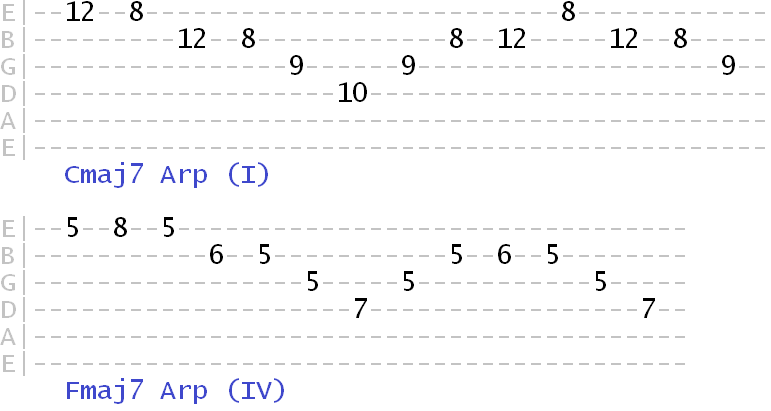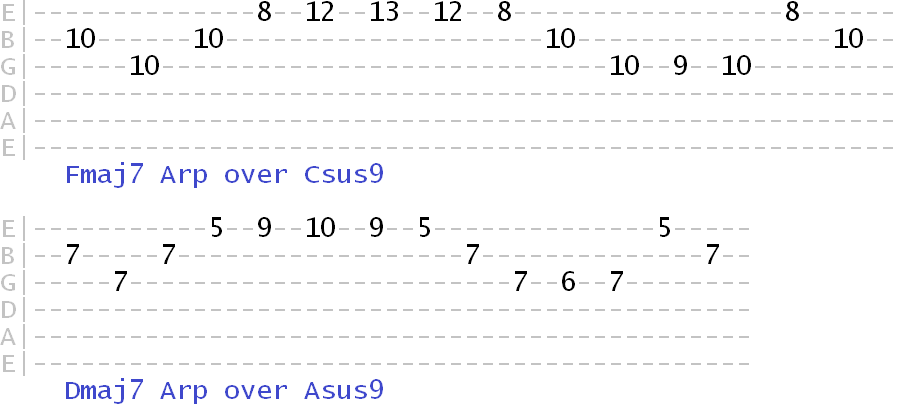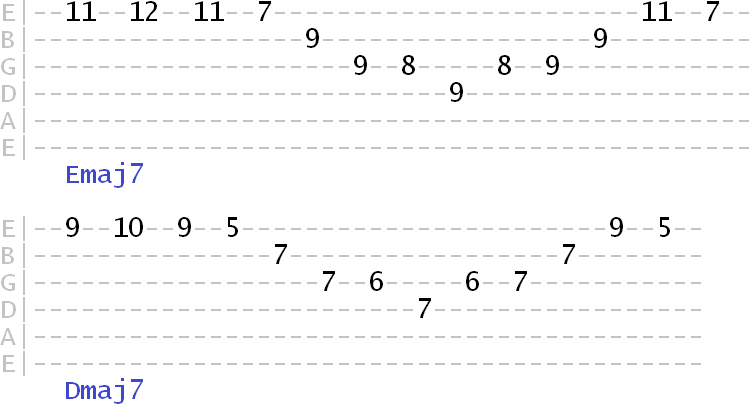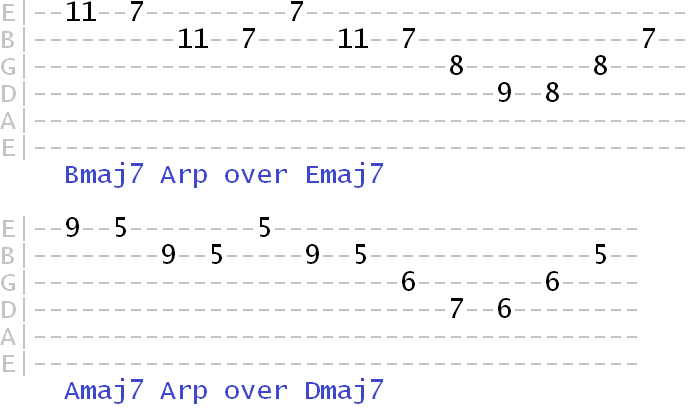Major 7th Arpeggio Basics
First, let's learn the ingredients that make up a major 7th arpeggio.
Below, we're starting on C major. Obviously we can play this chord in the open position. But for the purpose of soloing, it's more practical to start around a chord shape further up the neck.
So we might visualise a C major barre chord at the 8th fret...

Around this shape, we could build a C major arpeggio, taking the root, 3rd and 5th from around the chord and playing them sequentially...

But we could also add a major 7th interval, a half step down from the root, giving us a four-tone major 7th arpeggio (select the appropriate tab for intervals or fingering)...


The major 7th interval has a specific quality, which you can hear if you hold it over the major chord...
By adding that major 7th, we're effectively turning C major into Cmaj7. Remember, where there's an arpeggio, there's a chord...

Major 7th Arpeggio Patterns
As with scale patterns and chord shapes, there are a number of positions in which we can play this arpeggio.
6th String Root Patterns
Take this extended pattern built on the 6th string...


Or we could play a pattern that descends from that same root position...


5th String Root Patterns
We can also visualise patterns around 5th string root chord shapes...




Full Roadmap
What these positions allow us to do is play the arpeggio around any major chord in any place on the neck and also link them together into one large major 7th roadmap.
Can you see how the patterns from above connect up?
Cmaj7...

Emaj7...

Side note: As mentioned earlier, you can pull chord shapes out of these patterns. Using your knowledge of arpeggios across the neck is a great way to find chord shapes.
You don't need to include the root if you're accompanying other musicians (e.g. a bass player will have the root covered). Simply look for the 3, 5 and 7 and you can play three-string maj7 shapes in several places on the neck for any given chord.
And we don't always have to play through an entire pattern, across all 6 strings.
For example, we could just play across the top 2 or 3 strings of any given position...

So that's our basic major 7th arpeggio, which we can theoretically use over any occurence of a major or major 7th chord.
Playing Arpeggios Into Scales
In other lessons, I show you how to merge arpeggios into larger scale phrases. But as a quick example, here I'm starting with an arpeggio and leading in to a larger E major scale phrase.

So once you've learned the arpeggio patterns, it's useful to practice playing them into and out of related scales. The 2 most common scales that work with major 7th chords and arpeggios are Ionian or the major scale and Lydian. As you can see, both scales include the major 7th intervals.
Major 7th Arpeggios In Relative Positions
While major 7th arpeggios are typically played over major/maj7 chords with the same root, a lot of musicians don't realise that the arpeggio also works in relative positions to chords. Let me explain.
Going back to C major.
We're going to make this our tonic or 1 chord of the key, within a larger progression.
Over this chord, we might play a Cmaj7 arpeggio...

Let's say we moved to the 4 (IV) chord - F major.
We could also follow that change by changing our arpeggio root to F, since the 4 chord in major keys is naturally a major 7th chord...

But what's interesting is that we can keep our arpeggio on the 1 position over that 4 chord.
So we could play a Cmaj7 arpeggio over Fmaj. Take a listen....

Why does this work? Well, as you can see, the Cmaj7 arpeggio gives us the 5, 7, 2 and #4 of F major. The 2, #4 and 7 are natural colour tones over the 4 chord...

Although that effectively gives the arpeggio a different name, the only thing that matters is we're using the same Cmaj7 pattern to colour F major.
In fact, this same method of staying on the tonic root works over every chord in the natural major key.
In C major, we could play a Cmaj7 arpeggio (I'm using the same sequence as before) over its 2 (ii) chord, Dm...
Over its 3 (iii) chord, Em...
The 5 (V) chord. In this example, I'm playing over a G suspended chord (Gsus9) which, when coupled with the tonic major 7th arpeggio, sounds particularly nice...
The 6 (vi) chord, Am...
And finally the 7 (vii) chord, B diminished, commonly played as Bm7b5...
The reason this works is because the same tonic major 7th arpeggio touches on natural colour tones of each of chord in the key. So we're essentially extending the chord being played by using this arpeggio.
But we can also use these relative positions outside of natural keys.
For example, take the below movement between Csus9 and Asus9.
In each case we could treat each chord as if it was on the relative 5 (V) position. Therefore we might play Fmaj7 followed by Dmaj7...

Or take this movement, between Emaj7 and Dmaj7. Of course, we could complement these chords by playing an E major 7 and D major 7 arpeggio respectively...

But for variation, we could treat both of these chords as if they were 4 (IV) chords in relation to our arpeggio. This would mean playing Bmaj7 and Amaj7 arpeggios respectively...

And this relative concept also works over minor chords and keys.
For example, in the key of Am, we might play a C major 7 arpeggio, based on its relative major key tonic, which you could see as three frets up from the minor tonic root...

This will cover all of the Am key's natural chords.
In fact, with most occurences of a minor chord, one option for soloing is to play a major 7th arpeggio 3 frets up from that chord's root, also known as the relative major position.
Over G minor try a Bbmaj7 arpeggio...

Over C# minor try an Emaj7 arpeggio...

This all shows us that the major 7th arpeggio is incredibly versatile as a melodic system and works in relative positions to both major and minor chords.
So experiment with playing arpeggios on roots other than the chord you're playing over.
By doing this you can highlight chord colours using the same familiar pattern.
Let's put what we've learned to the test using some easy going backing tracks...
Major 7th Jam Tracks
Here I've picked out two tracks, courtesy of Chusss Music (check out his channel for a great library of backing tracks).
To accompany the tracks, I've provided the major 7th arpeggio patterns we can use over them (each chord has two options), as a starting point for building our lead phrases.
Chusss has also provided the pentatonic patterns in the track videos, so we have some decent mileage to play with - major 7th arpeggio + major pentatonic.
Emaj7 - Amaj7 (I - IV)
Emaj7 arpeggio over Emaj7

Bmaj7 arpeggio over Emaj7

Emaj7 arpeggio over Amaj7

Amaj7 arpeggio over Amaj7

Here we have a standard E major key movement between the 1 (Emaj) and 4 (Amaj).
- Over Emaj7, we have two options. Try an Emaj7 arpeggio or a Bmaj7 arpeggio. Why does Bmaj7 work? Because it adds a ♯4 (augmented 4th) to the Emaj7 chord. It has a bit more of a "jazzy" flavour.
- When the chord changes to Amaj7, we have two further options - simply stay on the Emaj7 arp (again for that ♯4 flavour) or move to a more "vanilla" Amaj7 arp, matching the root of the backing chord. Each creates a slightly different sound. But interchanging both options can give our playing more variation.
Amaj7 - Cmaj7 (I - ♭III)
Amaj7 arpeggio over Amaj7

Emaj7 arpeggio over Amaj7

Cmaj7 arpeggio over Cmaj7

Gmaj7 arpeggio over Cmaj7

A less conventional movement, but by using major 7th arpeggios as our foundation, we can keep our lead connected to the changes.
- Over Amaj7, simply play an Amaj7 arpeggio or try the jazzier approach of Emaj7.
- Over Cmaj7, try a Cmaj7 arp or give the chord some ♯4 spice by playing a Gmaj7 arp.
Whichever you choose, remember that there's a minor 3rd (three fret) root movement between the change. For example, Amaj - Cmaj7 or the relative Emaj7 - Gmaj7.
